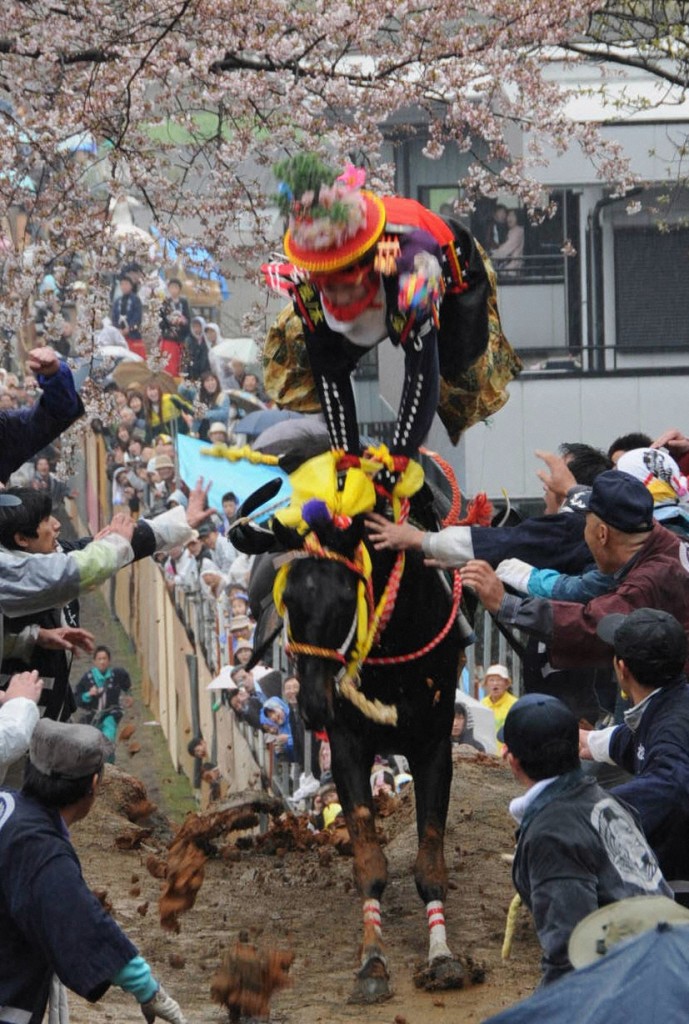
In the Ageuma Shinji unwilling horses have to be forced up steep slopes (courtesy JCAW)
Since Shinto is promoted as a nature religion, one might presume that green issues would be uppermost in its social thinking. However, this is often far from the case, as traditional interests and political support for right-wing nationalism take priority. It explains why many Shinto believers in Japan, contrary to expectations, actually support whaling and the dolphin massacre at Taiji.
Green Shinto has written of animal cruelty in Shinto before, particularly in the glaring example of the Ageuma Ritual held every May at shrines in Mie Prefecture. (For details of the ritual, please see here.)
The horseback ritual forms part of the Tado Festival, in which horses are forced up dangerously steep slopes, and five representatives of the shrines involved have faced animal cruelty charges (click here). Beating, bullying and sticking the horses in the ribs is how the animals are forced up the slope, leading often to injury.
The cruelty is defended by traditionalists who claim it has been carried out for centuries and is therefore somehow justified. It’s an absurd argument, which could be used to condone all manner of abuse from slavery to summary execution. Fortunately the Animal Rights group to which I belong has organised a campaign against the animal cruelty, and in the report below is an account of the results together with the present situation. I’m grateful to the Japanese Coalition for Animal Welfare for permission to reprint the report and for the photographs.
************************************************
“Part of this article is excerpted from the JCAW newsletter (The Japanese Coalition for Animal Welfare).”
Ageuma Shinji
1. JAWS Tokyo has been sending a petition to Inabe Shrine and Tado Shrine (both in Mie prefecture) to stop cruelty to the horses as a leading member of JCAW (The Japanese Coalition for Animal Welfare) since 2002.
2. We had conducted a strong campaign [No cruelty to Ageuma horses] in 2003
3. In 2004, both shrines declared an official promise to keep loyalty to mutual agreement between them and JCAW in the presence of Mie Local officials. So we stopped the campaign.
4. But there are no progress so far in 2006, so we sent a strong petition letter to both shrines again.
5 Five spectators were injured seriously by being involved in the horse accident.
6. Since we found more cruelty deed at the festival site, we sent a bill of indictment to Kuwana Police Department with Video tapes we made to prove many ill-treatments.
7. Kuwana police started investigation for both shrines
8. In 2011, Mie Council for the Protection of Cultural Properties discussed the cruelty issue and conducted inspection to both shrines. Thanks to both investigation and inspection, there was a dramatic improvement to reduce cruelty this year.
9. But we see some change for the worse this year 2014, and we are considering again to organize another campaign [No more cruelty at Ageuma].
Since Ageuma is seen as an traditional cultural event based on Shinto deeply rooted in local communities, it is so difficult to persuade local people involved to change their way of thinking and behavior. But we will keep fighting those ill treatment to the animals.
We don’t think it is a good idea to conduct online petitions, because those local people are not well accustomed to internet communications and there is always strong suspicion about misbehaving of net freaks on touchy issues in Japan.

An indication of the sickening challenges faced by the horses (courtesy JCAW)

I certainly agree that cruelty to animals ought to be minimized. I am a lifelong vegetarian for this very reason — it is natural for animals to eat other animals, and humans are certainly animals, but the way we go about it currently is far from natural. And I also believe that any spiritual institution’s community rituals ought to reflect its deepest values.
As far as Ageuma goes, it seems there is some leeway in the way that the ritual is conducted which would still allow it to be carried out without being unnecessarily cruel to the horses. The difficulty is that various people will have different ideas of what “unnecessarily cruel” actually means, of course.
It’s a little bit unclear to me from the excerpt you’ve posted, John– is JCAW hoping for the shrine to stop the rituals altogether? Or just hoping for modifications to how the ritual is carried out, e.g. no poking and prodding of ribs, lessening the distances of dramatic jumps, etc.?
Thank you for the feedback, Quin. The purpose of JCAW in this instance is to eliminate the cruelty, not the ritual itself. Of course that would mean changes to the traditional form of the ritual, such as choosing a different course or substituting humans for the horses, etc. Some might argue that this is tampering with tradition, but as we know tradition itself has been highly fluid over the centuries. Horse sacrifice was replaced by the practice of ema (horse pictures), for example. It might be a good model to follow….
Susanoo-no-Mikoto once tortured and killed a horse, and his impure act sent the Universe into the deepest darkness and him into banishment from the Celestial Plain. Over the aeons he redeemed and cleansed himself from his defiling act, but these folk, it seems they didn’t get the message, and it’s sad to see them partaking and renewing such impurity. May them purify themselves.
Thank you for that, Alexander. It’s a good point, and one I hadn’t thought of…
Thanks for covering this John. The JCAW report demonstrates the persistence sometimes required to address such issues and the importance of understanding the cultural context. For example, I was interested to read their comments about online petitions. These are very popular in the west yet appear unlikely to work in this instance. It is disappointing that the Japanese government has indicated that they will restart whaling in the Southern Ocean early next year, despite the ruling of the International Whaling Commission. We expect to see Sea Shepherd berthing once again in Hobart in their ongoing campaign to stop this practice. For the moment this seems to be more effective than international negotiations.
I have remarked in the past about the poor conditions animals face in Japanese zoos. No space to move around in, lack of natural environments being created for them etc. Okayama Zoo is quite bad in this respect. It is owned by the Ikeda family, which includes Ikeda Atsuko, sister of the Emperor and Sacred Priestess of Ise Jingu. Japanese Shinto needs better leadership than this.
Thank you for the observation, Iandalf, and I’m very much of your opinion too. Kyoto Zoo is an international disgrace, and the lack of compassion for the suffering of animals is sometimes difficult to comprehend. I think as Shinto spreads in the West, a very different approach to animal welfare will emerge.
Thanks for writing about this. I was thinking of attending this matsuri, as I love horses, and enjoy yabusame, chagu chagu and other festivals related to horse riding. Via this post, I realized how hideous ageuma actually is. Thanks for speaking out.
And thank you for taking the trouble to write in…